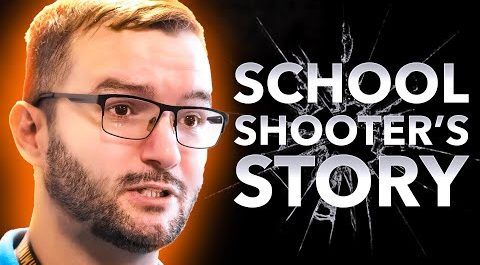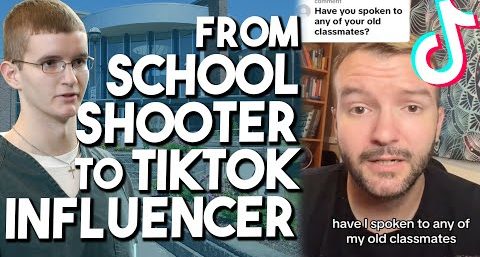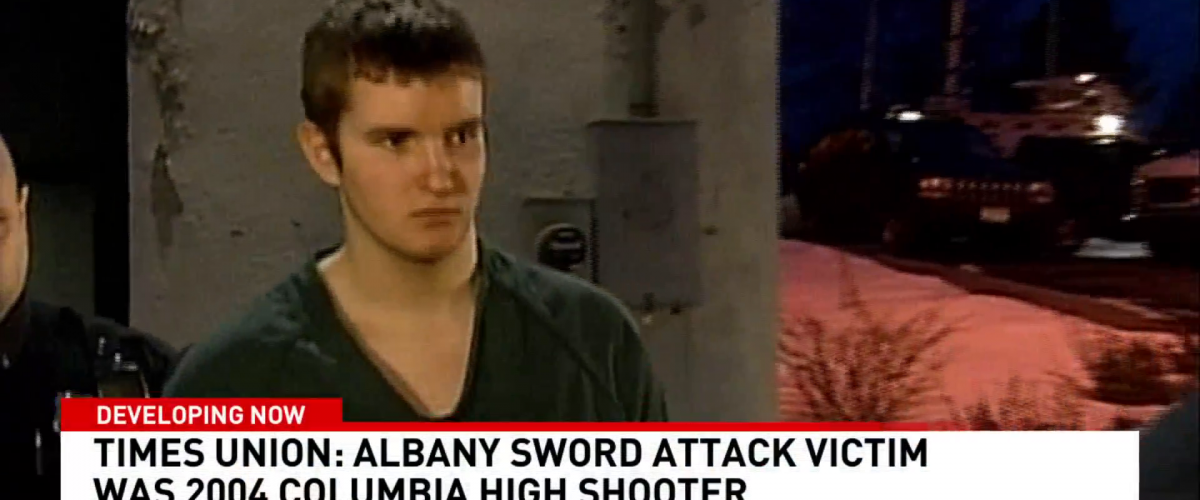Note: This article discusses attempted suicide, suicidal ideation and gun violence.
In the life of a school shooter, what happens almost 20 years after the crime?
On Feb. 9, 2004, 16-year-old Jon Romano left a suicide note at home before going to Columbia High School in Greenbush, N.Y., with a shotgun. Severely depressed, he wanted to die, but not alone.
When he arrived at the school, he fired shots throughout the hallway, aiming at the ceiling and away from a few of his peers who ran away when they saw the gun and heard the gun blasts. In some of Romano’s social media content recalling the incident, he claims this was to scare other students away, not to hurt them. He also hoped someone in the school would hear the noise and call 911. He wanted the police who arrived on the scene to shoot and kill him.
He walked around for a while before he stepped into a classroom, not to shoot other students or the teacher, but because “I wanted people to see me. To see the pain and the suffering that I was going through,” Romano recalls in a TikTok video.
He soon left the classroom and continued walking around the school until the vice principal attempted to restrain him. A special education teacher approached them to help, but as Romano and the vice principal struggled, the shotgun accidentally went off and injured the teacher.
Romano was arrested and charged with three counts of attempted murder, one charge of assault and 82 charges of reckless endangerment. He entered a plea deal and served 17 years in prison.
This is how Jon Romano recalls the incident at Columbia High School.

(news screen cap)
But what really happened?
According to public court documents, however, the story was a little different.
In February 2004, 16-year-old Jon Romano “wrote a suicide note and then took a loaded shotgun into the local high school that he had previously attended.” He entered the bathroom and for about 15 minutes waited and sent text messages to his friends warning them to leave. A few minutes later, Romano exited the bathroom, encountered a student and pointed the shotgun at him before the student ran into a nearby classroom. After this, Romano saw two other students in the hallway, one of whom made eye contact with him before he “pointed the shotgun directly at him and pulled the trigger.” The student “dropped to the ground as he saw a flash of fire from the barrel of the gun” but was not hit. The two students heard a second shot being chambered and began running and crawling away, and as Romano fired at them again, one student was grazed in the leg by the wadding of the shotgun shell.
After this, Romano “entered a classroom with the gun but was pulled back out by Assistant Principal John Sawchuck, who attempted to wrestle the shotgun away from him.” A teacher, Michael Bennett, “approached to assist Sawchuck,” but Romano “swung around and the gun went off, striking Bennett in the leg. At Sawchuck’s urging, (Romano) then agreed to give up the shotgun.”
Romano was subsequently arrested and taken to the Rensselaer County Jail, “where he was observed that night laughing at television news of the incident.”
According to witnesses
Based on accounts recorded by police right after the incident, it seems Romano’s public suicide attempt was more violent toward others than he is now describing on his social media pages. Many of the original accounts are available on this website created by a psychologist who profiles school shooters like Romano.
“It seems Romano’s public suicide attempt was more violent toward others than he is now describing on his social media pages.”
Rather than intentionally avoiding students and teachers, witnesses felt Romano was targeting them.
Eric Farrell, the first student who directly encountered Romano, told police, “He had a single-barrel shotgun in his hands and he raised it up and pointed it at me. He didn’t say anything. I was kinda in shock. I just looked at him and said, ‘Don’t do this man.’ I turned around and walked out. I walked out of the bathroom to the left and headed to the nearest classroom. … The kid with the shotgun was following me and as soon as I got in the classroom, I heard a shot go off.”
Jeffrey Kinary, who encountered Romano in the hallway with his peer, Casey Steponik, told police: “I made brief eye contact with him and he pointed the gun at me and pulled the trigger. I saw a flash of fire come from the barrel of the gun and I dropped to the ground. My ears began ringing immediately and I heard what I think was the next round being chambered. I immediately began half-running and half-crawling toward the stairwell and I heard a second shot at that time.” He also told police Steponik later discovered a hole in his hat where a bullet had penetrated the brim.
Casey Steponik, the student who was grazed in the leg by the wadding of the shotgun shell, told police of the incident: “I feel that Jon Romano was trying to kill me and Jeff in the hallway. I feared for my life. I have had no problems with Romano in the past and I have known him since the first or second grade. Last year, I heard him say that he hates this school and wanted to blow it up, but I just thought he was a kid talking and didn’t really mean anything by it.”
Another student witness named Travis Ellis, who was in a classroom Romano briefly entered, told police: “I heard the door be kicked open. I also heard the sound of a gun being cocked. I looked up and saw John walk into the classroom. John was carrying a shotgun. It had a long barrel. He was holding it with two hands across his body. John stood in the classroom near the door with the gun.” Ellis explained that, after looking around the classroom, Romano walked back out into the hallway, and they heard more gunshots.
In comparison with Romano’s newer retelling of the story, these original witness statements depict a much more violent incident, with a much angrier perpetrator.

Romano in 2004
As stated in both the original police report and Romano’s retelling of the incident, Romano left a note at home prior to his actions at Columbia High School. Soon after the incident, he spoke to police and sent letters to journalists discussing what happened.
Romano’s suicide note begins with a description of the struggles he was experiencing, which include psychological problems, abuse and a general fear for the future.
“I’m NOT A MONSTER,” he wrote, saying it is “SOCIETY” who should be blamed. He also made references to the movie Bowling for Columbine, a documentary that examines the 1999 school shooting and bombing of Columbine High School that killed 15 people. He ended the letter with a direct statement to Columbia High School: “Columbia, IT’S YOUR FAULT.”
In a voluntary statement to police on the day of the incident, Romano revealed his desire to commit gun violence had been festering for about a year. He explained: “I have had fantasies for about the last year of going in Columbia and shooting up the place. The fantasies were of me shooting random people.”
And while his recent statements imply that suicide was his only intention, he told police in this same 2004 statement there were at least two specific individuals he would have tried to kill if given the chance: “I really hate Mr. Crannel and Mr. Koosdale. They are principals at Columbia. They had no respect for me and lied to me. If I saw them, I would have shot them.”
According to assistant principal John Shawchuk’s statement, while they were waiting for police to arrive after Romano had surrendered his shotgun, he was “holding Jon down” while a teacher was asking him questions. When asked why he did this, Romano responded by telling the teacher about these individuals “hassling him.”
Sometime later, after Romano received his prison sentence, he wrote a letter to the editor of the Albany Times Union asking him to publish his writing in full, in which he described the incident as “the worst mistake” he ever made. In the letter, he expressed a desire to “make sure others don’t make that same mistake.” He encouraged readers to take their mental health seriously, blaming the incident on his desire to commit suicide. “But I want you to remember,” he pleaded, “when it comes to suicide or homicide, it’s a permanent answer to a temporary problem. There’s other ways of doing things.”
Throughout his prison sentence, Romano continued writing letters to the Albany Times Union, especially in response to other school shooting incidents, such as a letter from 2018 in which he references the shooting at Marjory Stoneman Douglass High School in Parkland, Fla. In this letter, he called for “life-saving policy changes” promoting gun control for America, which he describes as “a nation plagued by gun violence.”

So, what’s the story?
Romano was released from prison in 2020 and recently has gone viral for his efforts on social media to advocate for gun reform and teen mental health initiatives. Recognized by many across the internet as the man who was attacked by a sword while working at a homeless shelter, Romano has made many TikTok videos discussing how his experience as a school shooter inspired his recent activism. He has been interviewed by quite a few journalists and social media influencers who want to know more. Romano also works with local law enforcement to help provide information about preventing school shootings in the future.
And while many are encouraged by Romano’s desire to change his life and use his mistakes for good, others across social media are skeptical. Some are making videos calling him out for altering the story. They are criticizing him, saying he is using his status as a felon to become famous, and this is wrong because his actions were traumatizing and dangerous.
In response to these critiques, Romano has made multiple videos stating he does not want notoriety for his crimes. He also has claimed some of his former peers from Columbia follow him on social media, including some students who were at school the day of the shooting. Romano says he welcomes messages from them explaining the trauma they have because of the incident but also claims some of them support his activism today.
On his TikTok page, where he seems to be most actively posting, all public comments are currently turned off. He alleged in a recent video that this was because his supporters were receiving hate messages.
Across his content (which ranges broadly from prison stories, personal life events and content about the shooting), Romano claims he is not looking to pull the heartstrings of viewers. He does not ask for forgiveness for his crimes and says he knows they are inexcusable. He says his goal is to prevent future school shooting incidents by sharing his story and advocating for change.

Does his changing story matter?
But if the story he is sharing is different from official accounts, what does that mean?
The biggest difference between the original story and Romano’s newer accounts of the incident is a shift in how suicidality and mental health served as causational factors. In turn, this shift requires that some of the story’s details be changed.
In the original account found in public records, a desire to harm himself is present but does not seem to be the complete motivation for the crime. The suicide note, as well as witness accounts, indicate Romano was targeting Columbia High School generally and potentially his former principals specifically, because he blamed the institution for failing to respond adequately to his poor emotional state. While it is clear he did not expect to walk away from the incident alive, the original account indicates a desire (or at the very least, contemplation) to harm others, not just himself.
It was an expression of anger at his peers and educators for failing to respond to his struggles in ways he felt were adequate. Suicidal or not, Columbia High School was a target.
However, in his recent accounts, Romano stresses that harming others never was his intention; he just did not want to die alone. Creating this incident at Columbia was his way of doing this.
His newer accounts emphasize his alleged efforts to avoid shooting other students, but this greatly differs from the witness statements describing the incident back in 2004, including his own from that day, in which he admits to police that he would have shot his former principals if given the chance.
The new version of his story depicts a much different image of his 16-year-old self. It is an image of a teen who is not angry at his peers or his educators but one who has been overtaken by a deep hatred of only himself.
“For some angered social media users, this shift in self-portrayal seems to be ill-intentioned.”
And for some angered social media users, this shift in self-portrayal seems to be ill-intentioned; young Romano goes from an angry felon to a depressed teen who, as an adult, is touting personal growth for internet virality.
Romano has said in interviews before that he believes he has grown as a person since the incident, but he still acknowledges his crime was wrong, saying: “It doesn’t matter. That doesn’t undo what I’ve done.” He now claims poor mental health played a huge role in his desire to commit his crime.
Along with gun control, Romano is a massive supporter of mental health initiatives for teens. He believes a heftier focus on providing mental health resources will help end school shootings by preventing suicidality and thus reducing the chance students will attempt to harm themselves by putting their peers in danger.
However, as covered in previous BNG content, psychological researchers emphasize that factors such as depression and other mental illnesses are not consequential in a person’s decision to commit a mass shooting. Instead, one of the most common predictors of whether a person will commit a mass shooting is a desire for notoriety.
And although Romano claims his desire to end his life is what caused this particular instance of violence, it is important not to stigmatize mental health issues across the board or weaponize suicidality as a cause of mass violence. In fact, psychologists have noted that individuals who suffer from mental illness are more likely to be victims of crimes, not perpetrators. However, perpetrators are likely to seek diagnoses of mental illnesses (whether they have them or not) to receive lesser sentences for their crimes.
But many social media users still speculate that Romano, now going viral on the internet, is using his crime to gain notoriety. And they believe he is bolstering his efforts with a seemingly noble focus on mental health.
The bottom line
Whether social media users are right or not about Romano’s social media intentions, the bottom line is that there have been 540 mass shootings in the United States just this year, according to the Gun Violence Archive. Since October began, there have been 18.
In 2022, according to the Centers for Disease Control, 49,449 people died by suicide. Firearms were used 55% of the time.
Clearly, gun violence and suicide are both pressing issues in the United States, even if they are unrelated. If change is going to happen, it needs to happen soon.
Mallory Challis is a master of divinity student at Wake Forest University School of Divinity. She is a former BNG Clemons Fellow.


